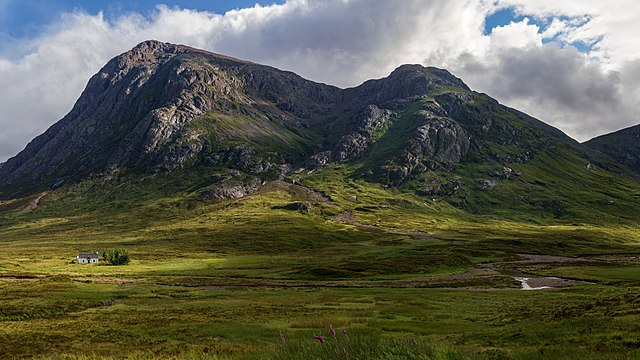Top Qs
Timeline
Chat
Perspective
Buachaille Etive Mòr
Mountain in the Scottish Highlands From Wikipedia, the free encyclopedia
Remove ads
Buachaille Etive Mòr (/ˈbuəxeɪl ˈɛtɪv ˈmɔːr/),[3] Scottish Gaelic: Buachaille Èite Mòr,[4] 'great herdsman of Etive'), also known simply in English as 'The Buachaille', is a mountain at the head of Glen Etive in the Highlands of Scotland. Its pyramidal shape, as seen from the northeast, makes it one of the most recognisable mountains in Scotland, and one of the most depicted on postcards and calendars.
Buachaille Etive Mòr is a large ridge nearly five miles (8 km) long, almost entirely encircled by the River Etive and its tributary the River Coupall. The ridge contains four main peaks: from north-east to south-west these are Stob Dearg (1,021.4 m), Stob na Doire (1,011 m), Stob Coire Altruim (941 m) and Stob na Bròige (956 m). Stob Dearg and Stob na Bròige are both Munros; the latter was promoted to Munro status by the Scottish Mountaineering Club in 1997.[5] To the west is the smaller ridge, Buachaille Etive Beag.
Remove ads
Climbing
Summarize
Perspective
The steep, craggy north-eastern face of Stob Dearg forms the classic aspect of the mountain as seen from the Kings House Hotel, and constitutes the most direct route of ascent for climbers and scramblers. Crowberry Ridge, a classic rock climb graded severe, was first climbed direct – and photographed – in 1900 by the Abraham brothers with Messrs Puttrell and Baker. Immediately to the left is Curved Ridge, one of the most famous scrambling routes.
Alternatively there is a somewhat eroded path leading steeply up the Coire na Tulaich which, in summer conditions, allows walkers to ascend the peaks, reaching the ridge about half a kilometre west of Stob Dearg.
Buachaille Etive Mòr is separated from its sister mountain of Buachaille Etive Beag to the west by the valley of Lairig Gartain. To the east lies Glen Etive, which provides an alternative route of ascent, heading up steep grassy slopes to the summit of Stob na Bròige. Another route follows the Allt Coire Altruim from the Lairig Gartain, reaching the ridge about two thirds of the way along from the north. This route is often used as descent route in conjunction with an ascent via Coire na Tulaich, forming a circular route with a walk out along the Lairig Gartain.
Injuries and deaths
Hillwalkers visiting Buachaille Etive Mòr have experienced injuries and even death due to the region's terrain and weather conditions. The mountain has seen up to 13 people die in one 12-month period.[6]
In 1994 one person died in an avalanche on Buachaille Etive Mòr.[6]
In February 1995, three people died when they were descending down the mountain and an avalanche occurred.[6] In 1995 there were six people who died on Buachaille Etive Mòr.[6]
In 2008 a person died in the same area of Buachaille Etive Mòr where an avalanche occurred in 2009.[6]
In January 2009, three people died and one was injured in an avalanche on Buachaille Etive Mòr.[7] The avalanche occurred in the Coire na Tulaich area of the mountain.[6] The following year, two climbers were killed by an avalanche on the mountain.[8]
In 2019, Terance Rooney died of hypothermia and exposure while hillwalking on Buachaille Etive Mòr.[9][10]
In April 2023, Royal Marine Reggie Melia fell 50 meters to his death while hiking on Buachaille Etive Mòr.[11]
Remove ads
Lagangarbh Hut

The only building in the vicinity of Buachaille Etive Mòr is Lagangarbh Hut, popularly referred to as a cottage on account of its appearance. It sits at the foot of Buachaille Etive Mòr, adjacent to the River Coupall, and near the A82. It is owned by the National Trust for Scotland, and managed by the Scottish Mountaineering Club, who make it available to hire as accommodation; up to 30 people can be accommodated.
Remove ads
In popular culture
Buachaille Etive Mòr appears in the background during a song sequence in the 1998 Bollywood film Kuch Kuch Hota Hai.[12][13] Together with Beinn a'Chrulaiste it can also be seen in the film Skyfall, where James Bond transports M away from the villain Raoul Silva. It was also the setting for the pop video "Whistle Down the Wind" by Nick Heyward.
Photography
The Buachaille has become synonymous with landscape photography in Scotland and is probably the most photographed mountain in the country. The most popular spot for this is the small waterfalls on the River Coupall to the east of the mountain. In recent years, the condition of the ground around these falls has deteriorated rapidly and many photographers now actively encourage staying away from the area to allow for regeneration. The site has also become popular for wedding photography with the mountain providing a dramatic backdrop.
- The Buachaille's north-east face
- Stob Dearg in spring
- Stob Dearg in autumn
- Stob Dearg in summer
Remove ads
See also
References
External links
Wikiwand - on
Seamless Wikipedia browsing. On steroids.
Remove ads









